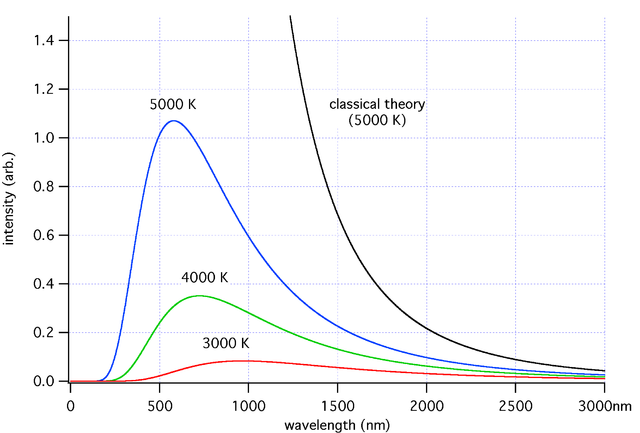热门问题
时间线
聊天
视角
普朗克黑体辐射定律
德国物理学家马克斯·普朗克(Max Planck)于1900年所提出的黑体辐射定律,描述热平衡状态下黑体在特定波长下辐射的光谱辐射量 来自维基百科,自由的百科全书
Remove ads
在物理学中,普朗克黑体辐射定律(英语:Planck's law,Blackbody radiation law,也简称作普朗克定律或黑体辐射定律)是指在任意温度下,从一个黑体中发射出的电磁辐射的辐射率与频率彼此之间的关系。在这里,辐射率是频率的函数[1]:
- ,

- ;
其中,或是辐射率,是频率,是波长,是黑体的温度,是普朗克常数,是光速,是玻尔兹曼常数。
注意这两个函数具有不同的单位:第一个函数是描述单位频率间隔内的辐射率,而第二个则是单位波长间隔内的辐射率。因而和并不等价。它们之间存在有如下关系:
- 。
通过单位频率间隔和单位波长间隔之间的关系,这两个函数可以相互转换:
- 。
在低频率极限,普朗克定律趋于瑞利-金斯定律,而在高频率极限,普朗克定律趋于维恩近似。
马克斯·普朗克于1900年发展出普朗克定律,并从实验结果计算出所涉及的常数。后来,他又展示,当表达为能量分布时,该分布是电磁辐射在热力学平衡下的唯一稳定分布。[2]当表达为能量分布时,该分布是热力学平衡分布家族的成员之一,其它成员为玻色–爱因斯坦分布、费米–狄拉克分布、麦克斯韦-玻尔兹曼分布等等。
Remove ads
概述

这是指单位频率在单位体积内的能量,单位是焦耳/(立方米·赫兹)。对全频域积分可得到与频率无关的能量密度。一个黑体的辐射场可以被看作是光子气体,此时的能量密度可由气体的热力学参数决定。
能量密度频谱也可写成波长的函数
下表中给出了函数中每一个物理量的意义和单位:
Remove ads
推导
下面的推导并非普朗克的原始推导(来源[4]),需要用到电动力学、量子力学和统计力学的有关概念。
考虑一个充满了电磁辐射的边长为的立方体:根据经典电动力学,在立方体壁表面的边界条件为电场的平行分量和磁场的垂直分量都为零。类似于处于束缚态的粒子的波函数,立方体内部的电磁场也是满足边界条件的周期性本征函数的线性叠加,在垂直于立方体壁表面的三个方向上各个本征函数的波长分别为 和
这里是非负整数。对于每一组值都有两个线性无关的解(两种不同的模)。根据量子力学中的谐振子理论,任意模式下的系统能级为
这里量子数可看作是立方体中的光子数,而两种不同模式对应的是光子的两种偏振态。注意到当光子数为零时能级不为零,这种电磁场的真空能量是一种量子效应,是产生卡西米尔效应的原因。下面我们计算在温度下光子数为零时系统处于真空状态下的内能。
根据统计力学,在特定模式下不同能级的概率分布由下式给出
这里
分母是系统在特定模式下的配分函数,它能够使概率分布归一化。对正则系综有
这里我们定义单个光子的能量为
系统的平均能量和配分函数的关系为
这个公式是玻色-爱因斯坦统计的一个特例。由于光子是玻色子,任一能级对光子的数量没有限制,系统的化学势为零。
系统的总能量是平均能量对所有可能的单光子态求和。考虑在热力学极限下,立方体边长趋于无穷大,这时单光子能量近似成为连续值,我们将平均能量对单光子的连续能量积分就可以得到系统的总能量,这就需要我们首先确定在任意给定的能量范围内具有多少个光子态。假设处于能级和的单光子态总数为(这里是所谓光子的能态密度,其具体表达式还需另行计算),则系统的总能量为
为计算光子能态密度的表达式,我们将(1)式重写成
这里是矢量的模
每一个矢量都对应有两个光子态,换句话说,在给定的一个由矢量构成的希尔伯特空间中的光子态总数是这个空间体积的2倍。一个微小的能量区间对应着这个希尔伯特空间中一个薄球壳的厚度。由于矢量的分量不能为负值,能量区间实际上只能对应整个薄球壳总体积的1/8(这是因为矢量有三个分量,每一个分量都为正数时的概率为1/8)。因而在能量区间上光子态总数为
将这个表达式代入(2)式,得到
注意到的三次方是立方体体积,因此可直接得到能量密度的表达式,将它写成频率的频谱函数
其中
这里即是黑体辐射的能量频谱密度,其意义为单位频率在单位体积内的能量。
如果写成波长的函数,
其中
这是黑体辐射的能量密度频谱的另一种形式,其意义为单位波长在单位体积内的能量。在玻色或费米气体情形下对这一函数积分需要用到多对数函数展开。但这里可以用初等函数的办法得到一个近似形式,数学上做代换
积分变量从而可写成如下形式
其中的表达式为
这一积分结果将后文附录中做说明。因而得到立方体中电磁场的总能量为
其中是立方体体积(注意:这个表达式不是斯特藩-玻尔兹曼定律,它的含义并不是理想黑体在单位时间内从单位表面积辐射出的总能量,参见斯特藩-玻尔兹曼定律条目)。由于辐射各向同性,并且以光速传播,能量的辐射率(单位时间单位立体角所对应辐射行进截面积及单位频率下辐射的能量)为
从而得到普朗克黑体辐射定律
Remove ads
历史

马克斯·普朗克于1900年建立了黑体辐射定律的公式,并于1901年发表[5]。其目的是改进由威廉·维恩提出的维恩近似(至于描述黑体辐射的另一公式:由瑞利勋爵和金斯爵士提出的瑞利-金斯定律,其建立时间要稍晚于普朗克定律。由此可见瑞利-金斯公式所导致的“紫外灾变”并不是普朗克建立黑体辐射定律的动机,参见后文叙述)。维恩近似在短波范围内和实验数据相当符合,但在长波范围内偏差较大;而瑞利-金斯公式则正好相反。普朗克得到的公式则在全波段范围内都和实验结果符合得相当好。在推导过程中,普朗克考虑将电磁场的能量按照物质中带电振子的不同振动模式分布。得到普朗克公式的前提假设是这些振子的能量只能取某些基本能量单位的整数倍,这些基本能量单位只与电磁波的频率有关,并且和频率成正比。
这即是普朗克的能量量子化假说,这一假说的提出比爱因斯坦为解释光电效应而提出的光子概念还要至少早五年。然而普朗克并没有像爱因斯坦那样假设电磁波本身即是具有分立能量的量子化的波束,他认为这种量子化只不过是对于处在封闭区域所形成的腔(也就是构成物质的原子)内的微小振子而言的,用半经典的语言来说就是束缚态必然导出量子化。普朗克没能为这一量子化假设给出更多的物理解释,他只是相信这是一种数学上的推导手段,从而能够使理论和经验上的实验数据在全波段范围内符合。不过最终普朗克的量子化假说和爱因斯坦的光子假说都成为了量子力学的基石。
很多有关量子理论的大众科普读物,甚至某些物理学课本,在讨论普朗克黑体辐射定律的历史时都犯了严重的错误。尽管这些错误概念在四十多年前就已经被物理学史的研究者们指出,事实证明它们依然难以被消除。部分原因可能在于,普朗克最初量子化能量的动机并不是能用三言两语就能够道清的,这里面的原因在现代人看来相当复杂,因而不易被外人所理解[6]。丹麦物理学家Helge Kragh曾发表过一篇文章清晰地阐述了这种错误是如何发生的[7]。

首先是尽管普朗克给出了量子化的电磁波能量表达式,普朗克并没有将电磁波量子化,这在他1901年的论文以及这篇论文对他早先文献的引用中就可以看到[5]。他还在他的著作《热辐射理论》(Theory of Heat Radiation)中平淡无奇地解释说量子化公式中的普朗克常数(现代量子力学中的基本常数)只是一个适用于赫兹振荡器的普通常数。真正从理论上提出光量子的第一人是于1905年成功解释光电效应的爱因斯坦,他假设电磁波本身就带有量子化的能量,携带这些量子化的能量的最小单位叫光量子。1924年萨特延德拉·纳特·玻色发展了光子的统计力学,从而在理论上推导了普朗克定律的表达式。
另一错误概念是,普朗克发展这一定律的动机并不是试图解决“紫外灾变”。“紫外灾变”这一名称是保罗·埃伦费斯特于1911年提出的,从时间上看这比普朗克定律的提出要晚十年之久。紫外灾变是指将经典统计力学的能量均分定理应用于一个空腔中的黑体辐射(又叫做空室辐射或具空腔辐射)时,系统的总能量在紫外区域将变得发散并趋于无穷大,这显然与实际不符。普朗克本人从未认为能量均分定理永远成立,从而他根本没有觉察到在黑体辐射中有任何“灾变”存在——不过仅仅过了五年之后,这一问题随着爱因斯坦、瑞利勋爵和金斯爵士的发现而就变得尖锐起来。
附录
有一个简便方法计算下面的积分
我们可以首先用替换式中的,计算一般形式下的积分
由于分母总是小于1,我们可以将它按展开写成收敛的几何级数
这就是几何级数的求和公式。等号左边的表达式正是右边的求和结果,右边的几何级数公比为.
从而得到
表达式乘以后相当于将变成,因而我们将求和符号中的序号加1,并消去原先的:
通过变量替换,我们得到以及,积分式进一步写成
即
形如上式的积分是收敛的,我们将求和的部分移到积分之外:
前面的求和系数正是黎曼ζ函数,而后面的积分正是Γ函数。从而我们得到一个一般的关系式:
或等价为
对于我们所需要的积分,积分式的分子为,因此代入上面等式中得到
这里我们用到了
Remove ads
参考文献
目录
参见
延伸阅读
外部链接
Wikiwand - on
Seamless Wikipedia browsing. On steroids.
Remove ads



















 ,
, 




































































